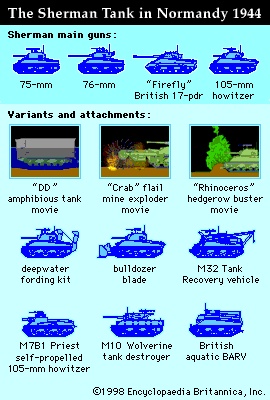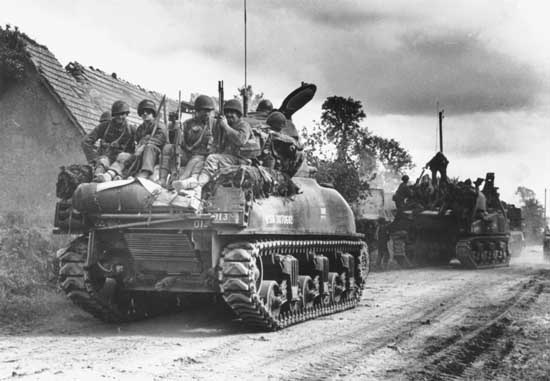Sherman tank
officially M4 General Sherman
 main battle tank designed and built by the United States for the conduct of World War II. The M4 was the most widely used tank series in the war, being employed not only by the U.S. Army and Marine Corps but also by British, Canadian, and Free French forces. The M4 was employed in North Africa, Sicily, Italy, and western Europe and throughout the Pacific theatre. A total of 49,324 Sherman tanks were produced in 11 plants between 1942 and 1946.
main battle tank designed and built by the United States for the conduct of World War II. The M4 was the most widely used tank series in the war, being employed not only by the U.S. Army and Marine Corps but also by British, Canadian, and Free French forces. The M4 was employed in North Africa, Sicily, Italy, and western Europe and throughout the Pacific theatre. A total of 49,324 Sherman tanks were produced in 11 plants between 1942 and 1946.When World War II began in 1939, the United States lagged far behind the major European states in the development of tank technology and armoured warfare doctrine. The fall of France in May 1940 awoke and alarmed the United States. The German army had defeated France in a matter of weeks through the use of a new operational doctrine based on fast-moving, massed armoured formations supported by air power. America's leaders became convinced that the U.S. Army needed a new main battle tank at least equal to that employed by the Germans and that it had to adopt German operational doctrine. To that end, in July 1940 the War Department authorized the development of a new medium tank, and it also authorized the organization of the first armoured divisions. By the time the Japanese attacked Pearl Harbor in 1941, the United States had five armoured divisions organizing and training for war in Europe.
The first American main battle tank employed in combat in World War II was the M3 General Grant, named for the American Civil War general Ulysses S. Grant. The British fought with this tank in North Africa as early as 1941. The M3 was the result of a crisis atmosphere that was prevalent immediately following the fall of France. It is likely that no tank in history ever went from design to production faster than the General Grant. Its major defect was its gun mount: the 75-mm gun was carried in a sponson in the right front of the hull and could traverse only 15 degrees—a major disadvantage in tank battles. However, the M3 was only an interim measure. Production ceased in late 1942, when the M4 went into full production.
The prototype of the M4, named for Grant's subordinate William Tecumseh Sherman, debuted in 1941 and was accepted for production that October. Its designers consciously emphasized speed and mobility, limiting the thickness of the armour and the size of the main gun, thereby compromising on firepower and survivability. The M4's main armament was a short-barreled, low-velocity 75-mm gun, and its armour thickness was a maximum of 75 mm and a minimum of 12 mm (3 inches and 0.5 inch). The tank had a maximum speed of 38 to 46 km (24 to 29 miles) per hour and a range of 160 to 240 km (100 to 150 miles), depending on the series (M4 to M4A3E2). The M4 carried a crew of five—commander, gunner, loader, driver, and codriver/hull gunner. The vehicle weighed about 33 tons, depending on the series. A typical power plant was a 425-horsepower gasoline engine.
 The M4 entered active service with the British in North Africa in October 1942. It was roughly in the same class as early versions of the German Pz. IV ( panzer), which at that time weighed 26 tons, had a road speed of 32 km (20 miles) per hour, and mounted a 60-mm gun. Later-model German tanks were much improved, so that by the time of the Normandy Invasion in June 1944 the M4 was outclassed by superior tanks such as the Pz. V (Panther) and the Pz. VI (Tiger). The American penchant for mass production tended to stymie innovations in technology, and American doctrinal thinking tended to remain stuck in the prewar period, when the tank was seen as primarily an infantry support weapon. As a result, the M4 was not “up-gunned” until late in the war, and American, British, and Canadian tank crews consistently faced better German tanks. The M4 had a faster rate of fire and greater speed, but both the Panther and the Tiger had significantly greater range and accuracy. The German tanks were also more survivable. Consequently, it took superior numbers for Anglo-American forces to defeat German armoured formations. The most notable effort to break the Germans' qualitative advantage was the Firefly, a Sherman equipped with a 76.2-mm long-barreled gun (a “17-pounder”).
The M4 entered active service with the British in North Africa in October 1942. It was roughly in the same class as early versions of the German Pz. IV ( panzer), which at that time weighed 26 tons, had a road speed of 32 km (20 miles) per hour, and mounted a 60-mm gun. Later-model German tanks were much improved, so that by the time of the Normandy Invasion in June 1944 the M4 was outclassed by superior tanks such as the Pz. V (Panther) and the Pz. VI (Tiger). The American penchant for mass production tended to stymie innovations in technology, and American doctrinal thinking tended to remain stuck in the prewar period, when the tank was seen as primarily an infantry support weapon. As a result, the M4 was not “up-gunned” until late in the war, and American, British, and Canadian tank crews consistently faced better German tanks. The M4 had a faster rate of fire and greater speed, but both the Panther and the Tiger had significantly greater range and accuracy. The German tanks were also more survivable. Consequently, it took superior numbers for Anglo-American forces to defeat German armoured formations. The most notable effort to break the Germans' qualitative advantage was the Firefly, a Sherman equipped with a 76.2-mm long-barreled gun (a “17-pounder”).For the Normandy Invasion and subsequent campaigns on the Continent, the M4 was retrofitted with special-purpose devices by both the Americans and the British. The British added flails (a system of rotors and chains) to clear paths through minefields, and American servicemen added jury-rigged plows for breaking through hedgerows in the bocage (France) country of Normandy. Perhaps the most famous variation was the “Duplex Drive,” or DD, tank, a Sherman equipped with extendable and collapsible skirts that made it buoyant enough to be launched from a landing craft and make its way to shore under propeller power. The M4 also was transformed into the M32 Tank Recovery vehicle and the M4 Mobile Assault Bridge carrier. Numerous devices of all sorts were fitted onto the Sherman's versatile, reliable chassis, making it the workhorse of the Anglo-American armies of World War II.
Additional Reading
George Forty, M4 Sherman (1987), is a well-illustrated work. R.P. Hunnicutt, Sherman: A History of the American Medium Tank (1978, reissued 1994), is also of interest.
- black oak
- Black Obelisk
- Black Panther Party
- black pepper
- blackpoll warbler
- Blackpool
- black powder
- Black Prince's ruby
- Black Range
- Black River
- Blackrock
- Black Rock Desert
- Black Rod
- Black Sabbath
- black sand
- Black Sea
- black shale
- black shark
- Blackshirt
- Black, Sir James
- blacksmith
- black snake
- Black Sox Scandal
- black spot
- Black Stone of Mecca